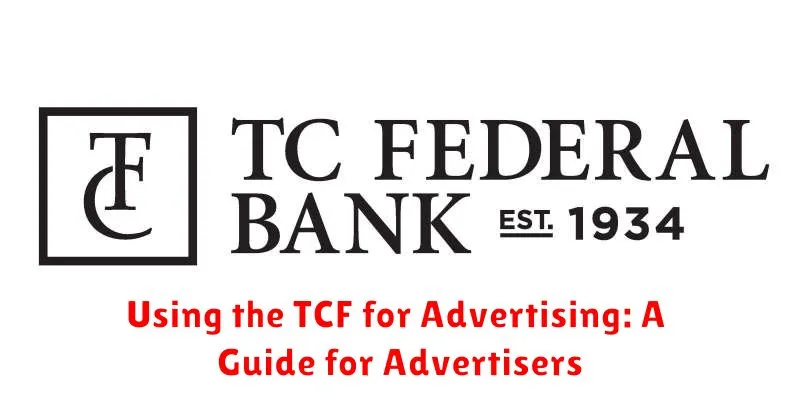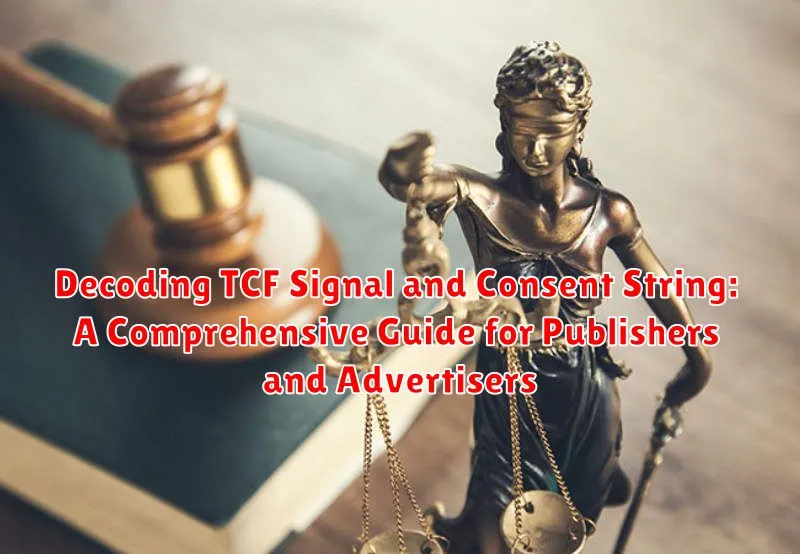In today’s complex digital advertising landscape, understanding the Transparency and Consent Framework (TCF) is crucial for both publishers and advertisers. Navigating the nuances of user consent and data privacy regulations, such as the General Data Protection Regulation (GDPR), requires a deep comprehension of the TCF signal and its underlying consent string. This comprehensive guide aims to demystify these critical components, providing a clear roadmap for ensuring compliance and maximizing the effectiveness of your advertising efforts within the boundaries of user privacy.
This article, “Decoding TCF Signal and Consent String: A Comprehensive Guide for Publishers and Advertisers,” will delve into the structure and interpretation of the TCF consent string. We will explore how publishers can effectively implement the TCF to gather and manage user consent, and how advertisers can leverage this information to deliver personalized ads while respecting user preferences. By understanding the intricacies of the TCF signal, businesses can foster trust with their audience, avoid potential legal pitfalls, and build a sustainable advertising ecosystem centered around ethical data practices. This guide serves as an essential resource for anyone involved in digital advertising who seeks to navigate the complexities of the TCF with confidence.
Understanding the IAB TCF (Transparency and Consent Framework): An Overview
The IAB Transparency and Consent Framework (TCF) is an industry standard designed to help websites, publishers, and advertisers comply with data protection regulations, particularly the General Data Protection Regulation (GDPR) and the ePrivacy Directive. It provides a standardized way to obtain and manage user consent for data processing activities related to online advertising.
At its core, the TCF aims to create transparency by enabling users to understand how their data is being used. It ensures that publishers and advertisers respect user choices regarding data collection and usage. The framework accomplishes this through a standardized consent signal, which communicates user preferences to the advertising ecosystem.
The TCF is governed by IAB Europe and continuously evolves to address changes in regulations and industry practices. Understanding the TCF is critical for any organization involved in digital advertising to ensure compliance and maintain user trust.
What is the TCF Signal? How It Relates to User Consent
The TCF Signal is a crucial component of the IAB’s Transparency and Consent Framework (TCF). It serves as an indicator of a user’s consent preferences, specifically regarding the processing of their personal data for advertising purposes. The signal informs all parties involved in the ad tech ecosystem – publishers, advertisers, and technology vendors – about the user’s choices.
User consent is the cornerstone of the TCF. The TCF Signal communicates whether a user has given consent for specific purposes (e.g., personalized advertising) and features (e.g., precise geolocation) as defined by the TCF policies. This signal ensures that data processing activities align with the user’s wishes, respecting their privacy rights as mandated by regulations like GDPR and CCPA.
In essence, the TCF Signal acts as a bridge between a user’s consent choices (expressed through a Consent Management Platform or CMP) and the actions of downstream advertising technologies. A valid TCF Signal is required for compliant ad operations.
The Anatomy of a Consent String: Decoding the Data
The Consent String, at the heart of the IAB TCF, is a standardized way to represent a user’s consent preferences. Understanding its structure is crucial for both publishers and advertisers.
The string is composed of several distinct sections, each encoded with specific information. Key components include:
- Version: Specifies the TCF version used to create the string.
- Consent Given: Indicates whether consent has been granted for specific purposes.
- Legitimate Interest Established: Reflects whether legitimate interest has been established for certain purposes.
- Vendor Consent/LI: Details the consent or legitimate interest status for individual vendors.
- Publisher Purposes Consent/LI: Shows publisher-specific purpose consent or legitimate interest.
The encoding method is typically base64url, allowing for efficient storage and transmission. By correctly decoding each section, you can determine a user’s preferences regarding data processing activities and vendor participation.
How the TCF Signal and Consent String Work: A Technical Breakdown
This section delves into the operational mechanics of the TCF signal and the consent string. The signal, essentially a flag, indicates whether a user’s consent preferences are available for processing. It’s typically communicated via JavaScript APIs or server-side mechanisms, informing ad tech vendors and publishers about the user’s status concerning tracking and data processing.
The consent string, on the other hand, is the actual encoded data representing the user’s choices. It’s a standardized string of characters that contains information about:
- Purposes: Which purposes the user consents to (e.g., personalization, ad delivery).
- Vendors: Which vendors the user consents to allowing to process their data.
- Special Features & Purposes: Whether the user consents to special features and special purposes.
- CMP ID: The ID of the Consent Management Platform (CMP) that generated the string.
This string is passed between parties in the advertising ecosystem, enabling vendors to tailor their behavior in accordance with the user’s expressed preferences. A CMP is responsible for obtaining and encoding consent, while vendors decode the string to understand and respect the user’s choices. Proper implementation ensures that ad tech services operate within the boundaries of user consent as defined by the GDPR and other privacy regulations.
Implementing the TCF: Best Practices for Publishers
Successfully implementing the IAB TCF requires a strategic approach. Publishers should begin with a comprehensive audit of their current data collection practices to identify areas needing adjustment.
Key Recommendations:
- Choose a Certified CMP: Select a Consent Management Platform (CMP) that is officially certified by the IAB. This ensures compliance and accurate signal transmission.
- Customize Consent Notices: Craft clear and concise consent notices that are easy for users to understand. Use plain language and avoid technical jargon.
- Prioritize User Experience: Integrate the CMP seamlessly into your website or app design to minimize disruption to the user experience.
- Regularly Review and Update: Stay informed about updates to the TCF specifications and regulatory guidelines. Update your implementation accordingly.
- Test Thoroughly: Before going live, thoroughly test your TCF implementation to ensure that consent signals are being correctly transmitted and interpreted by your advertising partners.
By following these best practices, publishers can effectively manage user consent and maintain compliance with privacy regulations.
Using the TCF for Advertising: A Guide for Advertisers

For advertisers, the TCF (Transparency and Consent Framework) provides a standardized method for receiving and interpreting user consent signals. This is crucial for ensuring compliance with privacy regulations like GDPR and ePrivacy Directive.
When participating in programmatic advertising, advertisers receive the TC String, which encapsulates user consent preferences. They must then parse this string to determine if they have the legal basis to process user data for purposes such as personalized advertising and measurement.
Key Considerations for Advertisers:
- Data Processing Purposes: Understand which purposes have consent or a legitimate interest basis according to the TC String.
- Vendor Status: Check if your advertising technology vendors are registered with the IAB TCF and respect the user’s expressed consent.
- Bid Adjustments: Adapt bidding strategies based on consent signals to avoid bidding on impressions where consent is not granted for your intended purposes.
Proper implementation of the TCF ensures that advertising practices align with user privacy preferences, fostering trust and mitigating legal risks.
TCF Compliance: Ensuring You Meet Regulatory Requirements
TCF Compliance is paramount for publishers and advertisers operating within the European Economic Area (EEA) and other regions governed by privacy regulations such as the General Data Protection Regulation (GDPR). Compliance ensures that user consent is obtained and managed transparently before processing personal data for advertising purposes.
Failure to comply with the TCF can result in significant penalties, including fines and legal action. Therefore, it’s crucial to understand and adhere to the framework’s requirements.
Key aspects of TCF Compliance:
- Transparency: Providing clear and easily accessible information to users about data processing purposes and vendor identities.
- Consent: Obtaining valid consent from users before processing their data. Consent must be freely given, specific, informed, and unambiguous.
- Record Keeping: Maintaining accurate records of consent obtained from users.
- Vendor Management: Ensuring that all vendors involved in data processing are also TCF compliant.
- CMP Integration: Implementing a certified Consent Management Platform (CMP) to collect and manage user consent signals effectively.
Regularly review and update your TCF implementation to reflect any changes in regulations or best practices. Consulting with legal counsel specialized in data privacy is highly recommended.
Troubleshooting TCF Implementation: Common Issues and Solutions
Implementing the IAB TCF can present various challenges. This section addresses common issues and offers solutions.
Common Issues:
- TCF Library Not Loading: Verify proper integration of the TCF JavaScript library and check for network connectivity issues.
- Consent String Not Being Passed Correctly: Ensure the consent string is being properly formatted and passed to advertising partners. Use developer tools to inspect network requests.
- CMP Configuration Errors: Review CMP settings for accuracy, including vendor lists, purpose configurations, and legal basis selection.
- Inconsistent Consent Signals: Investigate discrepancies between user consent choices and the signals being transmitted.
- Cookie Blocking: Some browsers and extensions block cookies, which can interfere with TCF functionality. Implement mechanisms to detect and address cookie blocking.
Solutions:
- Thorough Testing: Conduct comprehensive testing in different browsers and environments before launching.
- Regular Audits: Perform regular audits of your TCF implementation to identify and address potential issues.
- Consult Documentation: Refer to the official IAB TCF documentation and CMP provider guides.
- Seek Expert Assistance: If needed, consult with TCF experts for assistance with troubleshooting complex issues.
The Future of the TCF: Updates and Evolutions
The IAB Transparency and Consent Framework (TCF) is a dynamic standard, continuously evolving to adapt to the shifting privacy landscape and technological advancements. Understanding these future updates and evolutions is crucial for publishers and advertisers to maintain compliance and effectiveness.
Expected Updates
Future iterations of the TCF are likely to focus on several key areas, including enhanced user control, improved data portability, and greater harmonization with emerging privacy regulations. We can expect more granular consent options, making it easier for users to express their preferences with precision.
Evolutions in Technology
As new advertising technologies and methods emerge, the TCF will need to adapt. This includes addressing challenges posed by new forms of tracking and data processing. The framework’s evolution will necessitate ongoing technical refinements and clarifications to ensure it remains robust and relevant.
Staying Informed
Keeping abreast of the latest developments within the TCF ecosystem is paramount. This includes monitoring announcements from the IAB, participating in industry forums, and regularly reviewing the official TCF documentation to ensure ongoing compliance and optimal implementation.
TCF and User Experience: Balancing Compliance with User Preferences

The Transparency and Consent Framework (TCF) aims to standardize how user consent for online advertising is obtained and managed. However, implementing TCF effectively requires careful consideration of user experience (UX). Overly intrusive or confusing consent requests can lead to user frustration and negatively impact engagement.
A balance must be struck between compliance with privacy regulations and providing a positive and transparent user experience. Publishers should strive to present consent options in a clear, concise, and easily understandable manner.
Here are some factors to consider:
- Transparency: Clearly explain how user data will be used.
- Clarity: Use simple language and avoid technical jargon.
- Choice: Provide users with genuine control over their consent preferences.
- Design: Integrate consent requests seamlessly into the website or app’s design.
By prioritizing user experience in TCF implementation, publishers and advertisers can foster trust and maintain positive relationships with their audience while remaining compliant with relevant regulations.

